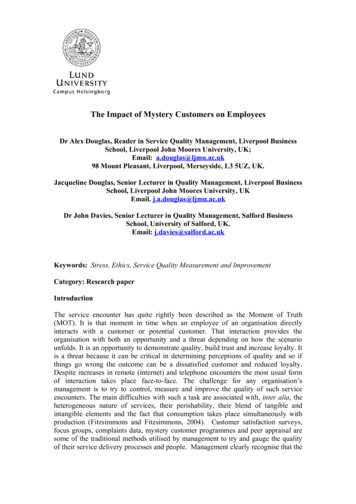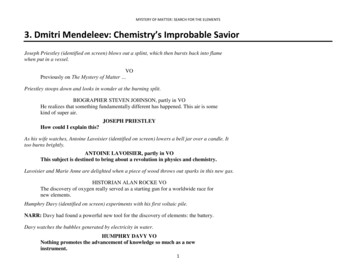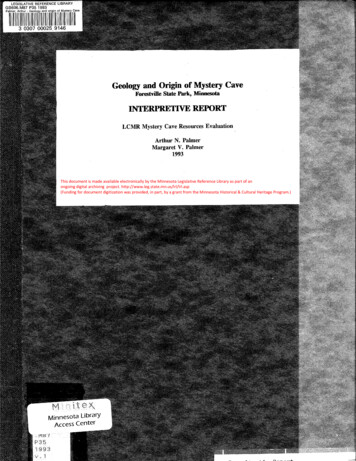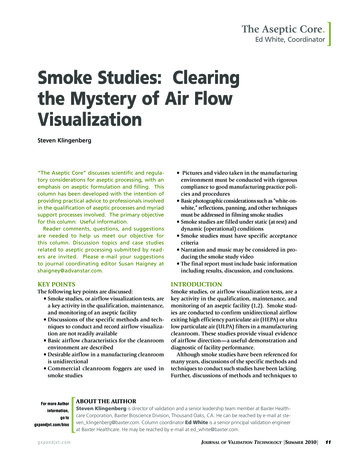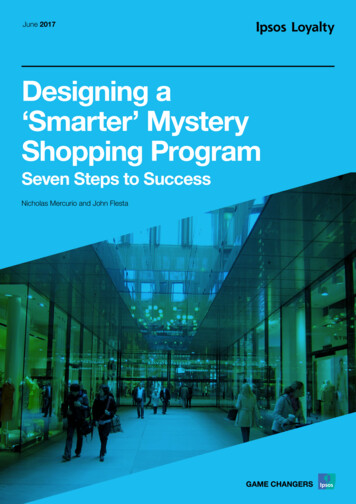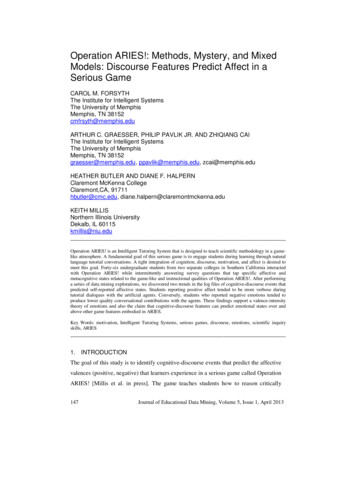
Transcription
Operation ARIES!: Methods, Mystery, and MixedModels: Discourse Features Predict Affect in aSerious GameCAROL M. FORSYTHThe Institute for Intelligent SystemsThe University of MemphisMemphis, TN 38152cmfrsyth@memphis.eduARTHUR C. GRAESSER, PHILIP PAVLIK JR. AND ZHIQIANG CAIThe Institute for Intelligent SystemsThe University of MemphisMemphis, TN 38152graesser@memphis.edu, ppavlik@memphis.edu, zcai@memphis.eduHEATHER BUTLER AND DIANE F. HALPERNClaremont McKenna CollegeClaremont,CA, 91711hbutler@cmc.edu, diane.halpern@claremontmckenna.eduKEITH MILLISNorthern Illinois UniversityDekalb, IL 60115kmillis@niu.eduOperation ARIES! is an Intelligent Tutoring System that is designed to teach scientific methodology in a gamelike atmosphere. A fundamental goal of this serious game is to engage students during learning through naturallanguage tutorial conversations. A tight integration of cognition, discourse, motivation, and affect is desired tomeet this goal. Forty-six undergraduate students from two separate colleges in Southern California interactedwith Operation ARIES! while intermittently answering survey questions that tap specific affective andmetacognitive states related to the game-like and instructional qualities of Operation ARIES!. After performinga series of data mining explorations, we discovered two trends in the log files of cognitive-discourse events thatpredicted self-reported affective states. Students reporting positive affect tended to be more verbose duringtutorial dialogues with the artificial agents. Conversely, students who reported negative emotions tended toproduce lower quality conversational contributions with the agents. These findings support a valence-intensitytheory of emotions and also the claim that cognitive-discourse features can predict emotional states over andabove other game features embodied in ARIES.Key Words: motivation, Intelligent Tutoring Systems, serious games, discourse, emotions, scientific inquiryskills, ARIES1. INTRODUCTIONThe goal of this study is to identify cognitive-discourse events that predict the affectivevalences (positive, negative) that learners experience in a serious game called OperationARIES! [Millis et al. in press]. The game teaches students how to reason critically147Journal of Educational Data Mining, Volume 5, Issue 1, April 2013
about scientific methods. The affective valences are reflected in self-reportedmetacognitive and meta-emotional judgments that college students provided after eachof the 21 different lessons. Our expectation was that the cognitive-discourse events thatreflect the students’ academic performance on critical scientific thinking (i.e. theserious subject matter at hand) should be an important predictor of their emotionalexperience regardless of the impact of the narrative and other features in the gameenvironment. However, our assumption may be incorrect. It may be instead that theother game aspects reign supreme and mask any impact of targeted cognitive-discoursefactors on the emotions that occur during the learning experience.The narrative features of games are known to have an influence on the students’emotional experience [Gee 2003; McQuiggan et al. 2010; Vorderer and Bryant 2006].For example, there is the dramatic theme in which a heroic protagonist saves the worldfrom destructive forces, a mainstay of movies, comic books and video games fordecades. That theme exists in SpyKids, a movie that draws many children to theaters. Inscience-fiction novels, teenagers fantasize about being the hero who saves the worldand wins the love of the pretty girl or handsome guy. Villains in these stories rangefrom a single nemesis, such as in the comic book Spiderman, to groups of extraterrestrials, such as “The Covenant” and “The Flood” in the science-fiction video gamefranchise “Halo” [Bungie.net]. These artificial worlds can be so engaging that gamersoften use an acronym with negative connotations to describe real life (i.e. “IRL” standfor “in real life”). Movies and video games make billions of dollars for developers byallowing a single person to become immersed in a fantasy world where he or she is ableto overcome seemingly in-conquerable antagonists and obstacles. It is not surprisingthat such narratives have an effect on players. Research in cognitive science anddiscourse processing has established that narratives have special characteristics [Bruner1986; Graesser et al.1994] that facilitate comprehension and retention compared withother representations and discourse genres [Graesser and Ottati 1996].Narrative is a feature that propels many serious games [Ratan and Ritterfeld 2009]and therefore a subject of interest for researchers. For example, Crystal Island[McQuiggan et al. 2010; Spires et al. 2010] is a serious game teaching biology that hasbeen used to investigate narrative, emotions, and learning. The tracking of emotionswithin this system shows that students tend to become more engaged when the narrativeis present compared with the serious curriculum alone. This engagement leads to148Journal of Educational Data Mining, Volume 5, Issue 1, April 2013
increased learning [McQuiggan et al. 2008; Rowe et al. 2011]. However, another line ofresearch [Mayer in press] suggests that the narrative component within the game may bedistracting and contribute to lower learning gains than the pedagogical features alone.Although fantasy is fun and exciting, it runs the risk of being a time-consuming activitythat can interfere with educational endeavors [Graesser et al. 2009; Mayer and Alexander2011; O’Neil and Perez 2008]. The verdict is not in on the relationship between narrativeand learning, but the impact of narrative on emotions clearly affects learning experiences.Aside from narrative, there are other features within a learning environment that arelikely to have an effect on emotions experienced by the student. It is conceivable thatcognitive, discourse, and pedagogical components of serious learning can influence theaffective experience [Baker et al. 2010; D’Mello and Graesser 2010; in press; Graesserand D’Mello 2012]. Research is needed to disentangle these aspects of a serious gamefrom the narrative aspects in predicting learner emotions. The cognitive, discourse, andpedagogical aspects may potentially have a positive, negative, or non-significant impacton emotions. For example, learning academic content is considered quite the opposite offun for many students. Instead of focusing on their uninteresting school activities,students are prone to spend many hours playing video games and immersing themselvesin worlds of fantasy [Ritterfeld et al. 2009]. The cognitive achievements in the mastery ofserious academic content would have little or no impact on the affective experience in aserious game if the narrative game world robustly dominates. In essence, games andserious learning launch two separate psychological mechanisms, with very little crosstalk, and the narrative game aspect dominates. An alternative possibility is that thecognitive, discourse, and pedagogical mechanisms still play an important role indetermining emotional experiences over and above the narrative game aspects.2. OVERVIEW OF OPERATION ARIES: A SERIOUS GAME ON SCIENTIFICCRTIICAL THINKINGMillis and colleagues [2011] developed the serious game OperationARIES! with the hopeof engaging students and teaching them the fundamentals of scientific inquiry skills. Thegame will be referred to as ARIES, an acronym for Acquiring Research Investigative andEvaluative Skills. The storyline embedded in ARIES contains narrative elements ofsuspense, romance, and surprise. The game teaches scientific inquiry skills while149Journal of Educational Data Mining, Volume 5, Issue 1, April 2013
employing the traditional theme of the single player saving the world from alien invadersthreatening eminent doom.Scientific reasoning was selected for ARIES because of the contemporary need forcitizens to understand scientific methods and critically evaluate research studies. This isan important skill for literate adults in both developed and developing countries. Whencitizens turn on the television or log on to the internet, they are inundated with researchreports that are quite engaging, but based on poor scientific methodology. One notableexample in both popular and academic circles is the inference of causal claims fromcorrelational evidence [Robinson et al. 2007]. For example, a recent study published thefinding that drinking wine reduces heart risk in women. The study was correlational innature but a causal claim was made. Perhaps it is true that drinking red wine is associatedwith reduced heart risk in women. But how can scientists legitimately claim that drinkingred wine causes reduced heart risk without the use of random assignment to groups?Perhaps women who drink red wine also exercise more or are less likely to smoke, twomore direct causes for reduced heart attacks, whereas there is no causal link betweenwine consumption and longevity. Most people are unable to distinguish true from falseclaims without training on scientific reasoning.ARIES teaches students how to critically evaluate such claims by participating innatural language conversations with pedagogical agents in an adaptive IntelligentTutoring System. ARIES has three modules: a Training module, a Case Study module,and an Interrogation module. It is the Training module that is under focus in the presentstudy so we will not present details about the Case Study and Interrogation modules. Inthe Training Module, students learn 21 basic concepts of research methodology,including topics such as control groups, causal claims, replication, dependent variables,and experimenter bias. The Case Study and Interrogation modules apply these 21concepts to dozens of specific research case studies in the news and other media.The Training module has 21 chapters that are associated with each of the 21 coreconcepts. For each chapter, the students completed four phases:Phase 1. Read a chapter in a book that targets the designated core concept (ortopic).Phase 2. Answer a set of multiple choice questions about the topic.150Journal of Educational Data Mining, Volume 5, Issue 1, April 2013
Phase 3. Hold a conversation about the topic with two conversational agents in atrialog, as discussed below. The students’ conversational contributionsserve as our predictor variables.Phase 4. Give ratings on metacognitive and meta-emotional questions that aredesigned to assess the students’ affective and metacognitive impressions ofthe learning experience. Such measures served as our criterion variables.ARIES has an internal architecture in the Training module that is similar to that ofAutoTutor, an Intelligent Tutoring System (ITS) with mixed-initiative natural languageconversations. AutoTutor teaches students computer literacy and physics usingExpectation-Misconception centered tutorial dialog [Graesser et al.2008; Graesser et al.2004; VanLehn et al. 2007]. The pedagogical methods used in AutoTutor have shownsignificant learning gains comparable to expert human tutoring [Graesser et al. 2004;VanLehn et al. 2007]. This type of tutoring conversation revolves around aconversational pedagogical agent that scaffolds students to articulate specificexpectations as part of a larger ideal answer to a posed question. In order to accomplishthis goal, the artificial teacher agent gives the students pumps (i.e., “Um. Can you addanything to that?”), appropriate feedback (“Yes. You are correct”, or “not quite”), hints,prompts to elicit particular words, misconception corrections, and summaries of thecorrect answer. The system interprets the students’ language by combining LatentSemantic Analysis [LSA, Landauer et al. 2007], regular expressions [Jurafsky and Martin2008], and weighted keyword matching. LSA provides a statistical pattern matchingalgorithm that computes the extent to which a student’s verbal input matches ananticipated expectation or misconception of one or two sentences. Regular expressionsare used to match the student’s input to a few words, phrases, or combinations ofexpressions, including the key words associated with the expectation. For example, theexpectation to a question in the physics version of AutoTutor is, “The force of impactwill cause the car to experience a large forward acceleration.” The main words here are“force,” “impact,” “car”, “large,” “forward,” and “acceleration.” The regular expressionsallow for multiple variations of these words to be considered as matches to theexpectation. Curriculum scripts specify the speech generated by the conversational agentas well as the various expectations and misconceptions associated with answers todifficult questions. A more in depth summary of the language processing used inAutoTutor is explained later in this paper as it applies to ARIES.151Journal of Educational Data Mining, Volume 5, Issue 1, April 2013
ARIES takes the pedagogy and principles of AutoTutor to a new level byincorporating multiple agent conversations in a game-like environment. ARIES holdsthree-way conversations (called trialogs) with the human student, who engages ininteractions with a tutor agent and a peer student agent. These conversations with andbetween the two agents are not only used to tutor the student but also to discuss eventsrelated to the narrative presented in ARIES. As with AutoTutor, the ARIES system hasdozens of measures that reflect the discourse events and cognitive achievements in theconversations. The log files record the agents’ pedagogical discourse moves, such asfeedback, questions, pumps, hints, prompts, assertions, answers to student questions,corrections, summaries, and so on. These are the discourse events generated by theagents, as opposed to the human student. The log file also records cognitive-discoursevariables of the human student, such as their verbosity (number of words), answer quality(semantic match scores to expectations versus misconceptions), reading times for texts,and so on. These measures are a mixture of the cognitive achievements and discourseevents so we refer to them as cognitive-discourse measures. The question is whetherthese cognitive-discourse measures that accrue during training predict the students’ selfreported affect (i.e., emotional and motivational metacognitive states) after lessons arecompleted with ARIES. Data mining procedures were applied to assess such predictivecorrelational relationships. It should be emphasized that the goal of the present study ison predicting these self-reported affective impressions, not on learning gains.The cognitive-discourse measures are orthogonal to the other game-like features ofARIES, such as the narrative storyline and multimedia presentations. An alternativepossibility is that the flashy dimensions of the game and narrative would account for theaffective experience, thus occluding any cognitive-discourse features measured duringthe pedagogical conversations. ARIES was designed to engage the student through acomplex storyline presented through video-clips, e-mails, accumulated points,competition, and other game elements in addition to the conversational trialogs. Withinthe Training module alone, the storyline allows for role-play, challenges, fantasy andmulti-media representations which are all considered characteristics that amplify thelearning experience in serious games [Huang and Johnson 2008]. The embedded storylineincludes interactive components with the student which is a mainstay of games [Whitton2010]. In addition, the student is given some player control over the course of theTraining module which may be an effective method of engaging students [Malone and152Journal of Educational Data Mining, Volume 5, Issue 1, April 2013
Lepper 1987]. The developers took care to attempt to balance the game-like features withthe pedagogical aspects to maximize the learning experience without over-taxing thecognitive system which can be a pitfall for serious game developers [Huang and Tettegah2010]. However, the possibility must be considered that perhaps these game-like featuresend up being so strong that cognitive-discourse features pale in comparison.3. EMOTIONS DURING LEARNINGContemporary theories of emotion have emphasized the fact that affect and cognition aretightly coupled rather than being detached or loosely connected modules [Isen 2008;Lazarus 2000; Mandler 1999; Ortony et al. 1988; Scherer et al.2001]. However, the roleof affect in learning of difficult material is relatively sparse and has only recentlycaptured the attention of researchers in the learning sciences [Baker et al. 2010; Calvoand D’Mello 2010; Graesser and D’Mello 2012]. A distinction is routinely made betweenaffective traits versus states, whether they be in clinical psychology [Spielberger andReheiser 2003] or advanced learning environments [Graesser et al. 2012]. A trait is apersistent characteristic of a learner over time and contexts. A state is a more transientemotion experienced by a student that would fluctuate over the course of a game session.For example, some people have the tendency to be frustrated throughout their lives andadopt that as a trait. In contrast, the state of frustration may ebb and flow throughout agame or any other experience. The same is true for many other academic and nonacademic emotions, such as happiness, anxiety, curiosity, confusion, boredom, and so on.Therefore, it is inappropriate to sharply demarcate emotions as being either traits or statesbecause particular emotions can be analyzed from the standpoint of traits (constancieswithin a person over time and contexts) and states (fluctuations within an individual andcontext). The present study addresses affective states rather than traits during the courseof learning.One explanation for the effect emotions have during learning is the broaden andbuild theory [Frederickson 2001], which was inspired by Darwinian theory.The broadenand build theory is based on the idea that negative emotions tend to require immediatereactions whereas positive emotions allow one to view the surroundings (broaden) andaccrue more resources in order to increase the probability of survival (build). In alearning environment, positive emotions have been associated with global processing,creativity and cognitive flexibility [Clore and Huntsinger 2007; Frederickson and153Journal of Educational Data Mining, Volume 5, Issue 1, April 2013
Branigan 2005; Isen 2008] whereas negative emotions have been linked to more focusedand methodical approaches [Barth and Funke 2010; Schwarz and Skumik 2003]. Forexample, students in a positive affective state may search for creative solutions to aproblem whereas one experiencing a negative affective state may only employ analyticalsolutions. This is one explanation of the effect of emotions on learning, but there areothers.Another explanation of the relationship between affect and learning considers thematch between the task difficulty level and the student’s skill base. The theoreticallyperfect task for any student would be one that is neither too easy nor too difficult butrather within the student’s zone of proximal development [Brown et al. 1998; Vygotsky1986]. When this optimal alignment occurs, students may experience the intense positiveemotion of flow [Csikszentmihalyi 1990] in which time and fatigue disappear. There issome evidence that students are in this state when they quickly generate information andare receiving positive feedback [D’Mello and Graesser 2012; 2010]. For example, astudent in the state of flow may make many contributions to tutorial conversations andremain engaged for an extended period of time. Conversely, a student who is in anegative emotional state may only make minimal contributions, experience numerousobstacles, and thereby experience frustration or even boredom.Students’ self-efficacy or beliefs about their ability to complete the task may alsorelate to emotional states experienced during learning. Specifically, students whoappraise themselves to be highly capable of successfully completing a task areexperiencing high self-efficacy. These students exert high amounts of effort andexperience positive emotions [Dweck 2002]. Conversely, students who feel that failure iseminent will exert less effort, perhaps resulting in insufficient performance and negativeemotions. However, beliefs of self-efficacy may dynamically change throughout alearning experience [Bandura 1997], thus acting as states rather than traits of the student.For example, a student may begin a task with a relatively high level of self-efficacy andthen discover that the task is more difficult than expected, leading to a decreased level ofself-efficacy. Students take into account previous and current performance when formingthese transient beliefs about current states of self-efficacy.Traits such as motivation and goal-orientation may add another dimension to thecomplex interplay between emotions and learning. Pekrun and colleagues [2009] suggesta multi-layered model of learning, motivation, and emotion. Pekrun’s model, known as154Journal of Educational Data Mining, Volume 5, Issue 1, April 2013
the control-value theory of achievement emotions, posits that the motivation or goalorientation of the student is correlated with specific emotions during learning, such asenthusiasm and boredom. The student’s goal-orientation can be focused on either masteryor performance. A student with mastery goal-orientation wants to learn the material forthe sake of acquiring knowledge. This type of student sees value in learning simply forthe sake of learning. In contrast, a student with performance goal-orientation wants toonly learn enough information to perform well on an exam. Mastery- oriented studentsare more likely to achieve deep, meaningful learning, while the latter is likely to onlyacquire enough shallow knowledge to get a passing grade [Pekrun 2006; Zimmerman andSchunck 2008]. These two types of learners are likely to experience two vastly differentemotional trajectories [D’Mello and Graesser 2012]. Mastery-oriented students mightexperience feelings of engagement when faced with a particularly difficult problem,because difficult problems provide the opportunity to learn, grow, and conquer obstacles.They might even experience the aforementioned state of flow. That is, when an obstaclepresents itself, the student experiences and resolves confusion and thereby maintains astate of engagement. On the other hand, performance-oriented students might feelanxiety, stress, or frustration when faced with a difficult problem, since performingpoorly might threaten their grade in the class. When this type of student is faced withsuch problems, the student may experience confusion followed by frustration, boredomand eventual disengagement. The affective trajectories of the two separate goal-orientatedtraits of students results in an aptitude-treatment interaction, which is quite interesting butbeyond the scope of this article to explore. The current study focuses on moment-tomoment affective states during the process of learning.Several studies have recently investigated the moment-to-moment emotions humansexperience during computer-based learning [Arroyo et al. 2009; Baker et al. 2010;Kapoor et al. 2007; Calvo and D’Mello 2010; Conati and Maclaren, 2009; D’Mello andGraesser 2012; Litman and Forbes-Riley 2006; McQuiggan et al. 2010]. Conati andMaclaren conducted studies on the affect and motivation during student interaction withan Intelligent Tutoring System called PrimeTime. These studies collected data in both thelaboratory and school classrooms [Conati et al.2003; Conati and Maclaren 2009].Emotions were detected by physical sensors which were recorded in log files along withcognitive performance measures. These studies resulted in a predictive model of learners’155Journal of Educational Data Mining, Volume 5, Issue 1, April 2013
goals, affect, and personality characteristics, which are designated as the student models[Conati and Maclaren 2009].Baker and colleagues [2010] investigated emotions and learning by trackingemotions of students while interacting in three very different computer learningenvironments: Graesser’s AutoTutor (as referenced earlier), Aplusix II Algebra LearningAssistant [Nicaud et al. 2004], and a simulation environment in which students learnbasic logic called The Incredible Machine: Even More Contraptions [Sierra Online Inc.2001]. Baker et al. investigated 7 different affective states (i.e. boredom, flow, confusion,frustration, delight, surprise and neutral). Among other findings, the results revealed thatstudents who were experiencing boredom were more likely to “game the system”, astudent strategy to trick the computer into allowing the student to complete theinteraction without actually learning [Baker et al. 2006; Baker and deCalvalho 2008].Frustration was expected to negatively correlate with learning, but it was low infrequency. Interestingly, confusion was linked to engagement in this study and has alsobeen linked to deep level learning in previous studies [D’Mello et al. 2009]. Baker et al.[2010] advocated more research on frustration, confusion, and boredom in order to keepstudents from disengaging while interacting with the intelligent tutoring systems.A series of studies examined emotions while students interacted with AutoTutor,which has similar conversational mechanisms as ARIES except that ARIES has 2 ormore conversational agents and AutoTutor has only one agent. These studies conductedon AutoTutor investigated emotions on a moment-to-moment basis during learning[Craig et al. 2008; D’Mello et al. 2009; D’Mello and Graesser 2010; D’Mello andGraesser 2012; Graesser et al. 2008]. The purpose of these studies was to identifyemotions that occur during learning and uncover methods to help students whoexperienced negative emotions such as frustration and boredom. As already mentioned,the most frequent learner-centered emotions in the computerized learning environmentswere confusion, frustration, boredom, flow/engagement, delight and surprise. Theseemotions have been classified on the dimension of valence, or the degree to which anemotion is either positive or negative [Barrett 2007; Isenhower et al. 2010; Russell 2003].That is, learner-centered emotions can be categorized as having either a negative valence(i.e., frustration and boredom), a positive valence (flow/engagement and delight), orsomewhere in-between, depending on context (e.g., confusion and surprise).156Journal of Educational Data Mining, Volume 5, Issue 1, April 2013
Positively- and negatively-valenced emotions have been shown to correlate withlearning during student interactions with the computer literacy version of AutoTutor[Craig et al. 2004, D’Mello and Graesser 2012]. Specifically, positive emotions such asflow/engagement correlate positively with learning, whereas the negative emotion ofboredom shows a significant negative correlation with learning. Interestingly, thestrongest predictor of learning is the affective-cognitive state of confusion, a state whichmay be either positive or negative, depending on the attribution of the learner. A masteryoriented student may regard confusion as a positive experience that reflects a challenge tobe conquered during the state of flow. A performance-oriented student may viewconfusion as a negative state to be avoided because it has accompanying negativefeedback and obstacles. Available research suggests there may be complex patterns ofemotions that impact learning gains rather than a simple relationship [D’Mello andGraesser in press; Graesser and D’Mello 2012]. Methods in educational data mining areexpected to help us discover such relationships.One motive for uncovering the complex array of emotions experienced duringlearning is to create an adaptive agent-based system that is responsive to studentsexperiencing different emotions. Many systems with conversational agents have beendeveloped during the last decade that have a host of communication channels, such asgestures, posture, speech, and facial expressions in addition to text [Atkinson 2002;Baylor and Kim 2005; Biswas et al. 2005; Graesser et al. 2008; Graesser et al. 2004;Gratch et al. 2001; McNamara et al. 2007; Millis et al. 2011; Moreno and Mayer 2004].In order to provide appropriate feedback to the student, the system must be able to detectemotions on a moment-to-moment basis during learning. This requires an adequate modelthat detects if not predicts the students’ emotions.The current study probed students’ self-reported impressions of their learningexperiences with respect to emotions, motivation, and other metacognitive states afterthey interact with lessons in the Training module of ARIES. ARIES is an ITS similar toAutoTutor but it has game features and multiple agents. Unlike many of the AutoTutorstudies on emotions, the current investigation has an added component of ecologicalvalidity because data were collected in two college classrooms. We did not want todisrupt the natural flow of classroom learning, so the students were not hooked up totechnological devices that sense emotions. Additionally, the nature of the design included157Journal of Educational Data Mining, Volume 5, Issue 1, April 2013
students working in dyads to complete interaction of ARIES. Students often work in pairsin classes so that a solitary student is not stuck for long periods of time.The detection of emotions was based entirely on self-report measures collected afterstudents completed each of the 21 chapters on research methodology. Self-report hasbeen used in studies determining the validity of both linguistic [D’Mello and Graesser inpress] and non-verbal affective features [Craig et al. 2004]. The survey questions did notask students open-ended questions such as “how do you feel?” Instead, the questionsasked
Operation ARIES!: Methods, Mystery, and Mixed Models: Discourse Features Predict Affect in a Serious Game CAROL M. FORSYTH The Institute for Intelligent Systems The University of Memphis Memphis, TN 38152 cmfrsyth@memphis.edu ARTHUR C. GRAESSER, PHILIP PAVLIK JR. AND ZHIQIANG CAI The Institute for Intelligent Systems The University of Memphis


